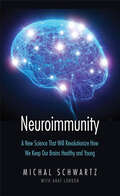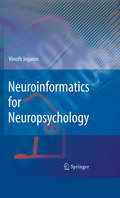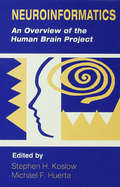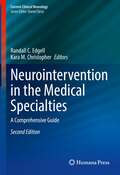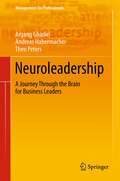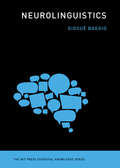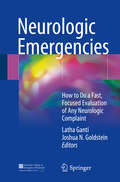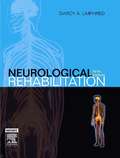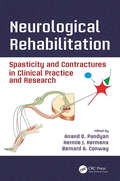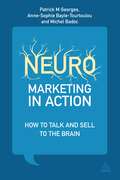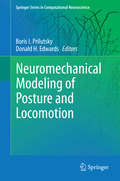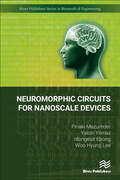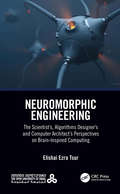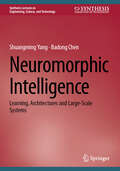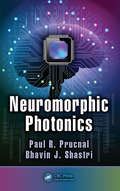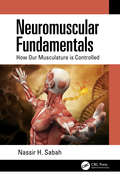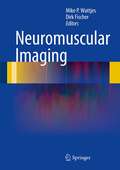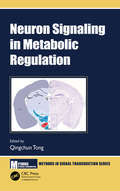- Table View
- List View
Neuroimmunity: A New Science That Will Revolutionize How We Keep Our Brains Healthy and Young
by Michal Schwartz Anat LondonHow pathbreaking research into the brain’s connections to the immune system offers new hope for treating diseases, injuries, and the effects of aging. PROSE Awards Honorable Mention, Biomedicine & Neuroscience categoryIn the past, the brain was considered an autonomous organ, self-contained and completely separate from the body’s immune system. But over the past twenty years, neuroimmunologist Michal Schwartz, together with her research team, not only has overturned this misconception but has brought to light revolutionary new understandings of brain health and repair. In this book Schwartz describes her research journey, her experiments, and the triumphs and setbacks that led to the discovery of connections between immune system and brain. Schwartz, with Anat London, also explains the significance of the findings for future treatments of brain disorders and injuries, spinal cord injuries, glaucoma, depression, and other conditions such as brain aging and Alzheimer’s and Parkinson’s diseases.Scientists, physicians, medical students, and all readers with an interest in brain function and its relationship to the immune system in health and disease will find this book a valuable resource. With general readers in mind, the authors provide a useful primer to explain scientific terms and concepts discussed in the book.
Neuroinflammation, Gut-Brain Axis and Immunity in Neuropsychiatric Disorders (Advances in Experimental Medicine and Biology #1411)
by Yong-Ku KimThis book reviews the relationship between cytokines, glia, and neurons in the pathophysiology of neuropsychiatric disorders and examines the mechanisms of action of the drugs used for the treatment of these disorders. Increasing evidence has suggested that glia perform important roles in various brain functions, but much remains to be learned about these crucial cells and their interplay with neurons. In addition, a better understanding of the interaction between inflammatory mediators, such as cytokines, and the activated immune response will be of critical importance for the development of new therapeutic strategies. These key areas are the focus of this book, which documents the latest research findings in the field. Evidence is provided for the role of inflammation-induced toxic metabolites from the tryptophan pathway in a wide range of neuropsychiatric disorders, including depression, schizophrenia, and Alzheimer's disease. In presenting state of the art knowledge on the interactions between cytokines, glia, and neurons, the book will help to pave the way for the development of novel targets for the prevention and treatment of neuropsychiatric disorders.
Neuroinformatics for Neuropsychology
by Vinoth JagarooBioinformatics involves specialized application of computer technology to investigative and conceptual problems in biology and medicine; neuroinformatics (NI) is the practice of bioinformatics in the neurosciences. Over the past two decades the biomedical sciences have been revolutionized by databases, data mining and data modeling techniques. The Human Genome Project, which depended on informatics methods, has been the most well recognized bioinformatics undertaking. Bioinformatics has since been applied all across biology and medicine, and has also transformed almost every avenue in neuroscience. Yet in neuropsychology, NI perspectives remain largely unrealized. Ironically, NI offers enormous potential to the essential praxis of neuropsychology - assessing cognitive behavior and relating cognition to neural systems. Neuroinformatics can be applied to neuropsychology as richly as it has been applied across the neurosciences. Neuroinformatics for Neuropsychology is the first book to explain the relevance and value of NI to neuropsychology. It systematically describes NI tools, applications and models that can enhance the efforts of neuropsychologists. It also describes the implications of NI for neuropsychology in the 21st century - fundamental shifts away from the conventional modes of research, practice and communication that have thus far characterized the field. One of the foremost experts on the subject: Illustrates the vital role NI is playing throughout the neurosciences. Provides a sampling of NI tools and applications in neuroscience research, and lays out current organization structures that support NI. Describes the lack of NI in neuropsychology, differentiates between NI systems for neuropsychology and conventional computerized assessment methods, and proposes criteria for neuropsychology-specific NI systems. Describes NI applications and models currently in use in neuropsychology, and NI models for neuropsychology that are being pioneered in phenomics research. Discusses potential obstacles and aids to NI in neuropsychology, including issues such as data sharing, standardization of methods, and data ontology. Projects the future of neuropsychological research and practice in light of the new generation of the internet, Web 2.0, geared to collective knowledge building. A vital introduction to a profound technological practice, Neuroinformatics for Neuropsychology is important reading for clinical neuropsychologists, cognitive neuroscientists, behavioral neurologists, and speech-language pathologists. Researchers, clinicians, and graduate students interested in informatics for the brain-behavioral sciences will especially welcome this unique volume.
Neuroinformatics: An Overview of the Human Brain Project (Progress in Neuroinformatics Research Series #401)
by Michael F. Huerta Stephen H. KoslowModern neuroscience is providing profound insights into nature's most mysterious puzzle -- the human brain -- while applications of information and computer science are transforming the way people interact with each other and with the world around them. The new science of neuroinformatics, which sits at the junction, integrates knowledge and promises to catalyze progress in these dynamic and seemingly disparate areas of study. Neuroinformatics research will allow brain and behavioral scientists to make better sense and use of their data through advanced information tools and approaches. These include new ways to acquire, store, visualize, analyze, integrate, synthesize, and share data, as well as the means for electronic scientific collaboration.In this country, the principal source of support for neuroinformatics research is the Human Brain Project. The project, which is led by the National Institute of Mental Health, now supports neuroinformatics research performed by over 60 scientists. This volume presents the findings of the first group of researchers. Their efforts will begin to arm the next generation of brain and behavioral scientists with tools to attack the serious problem of information overload, and ultimately relate their findings to those obtained from different species, levels of biological organization, methods, and laboratories. And the challenges presented by the amount, diversity, and complexity of brain and behavioral data will give informatics researchers the impetus to test and expand the limits of their own science. The work described in this volume signals a change in the way scientists interact with data, instruments and each other, and points the way to a very different and richer future understanding of the human brain and mind.
Neurointervention in the Medical Specialties: A Comprehensive Guide (Current Clinical Neurology)
by Randall C. Edgell Kara M. ChristopherThis book covers the intersections between neurointervention and neurology, neurointervention and neurosurgery, and neurointervention and other specialties. It fills the gap in the literature by placing specific emphasis on appropriate patient selection, preparation, and post-procedural management. Concise and comprehensive, this text covers the increasingly important aspects of the neurointerventionalist profession, as it has moved away from a purely technical role to a focus on clinical care. In addition, the most rapidly expanding area of neurointervention, ischemic stroke, is thoroughly examined in this text, where other texts on this subject fail. It is also meant as a reference for non-neurointerventionalists who may desire to learn more about how their patients can benefit from the therapeutic or adjunctive techniques that the neurointerventionalist can provide. Neurointervention in the Medical Specialties, Second Edition is an essential guide written for neurointerventional specialists from all backgrounds, both in practice and in training
Neuroleadership: A Journey Through the Brain for Business Leaders
by Theo Peters Argang Ghadiri Andreas HabermacherThis book takes you on a journey through the brain, its function and its impact on leadership. The young business field of neuroleadership is founded on the belief that understanding the brain can give leaders new and powerful insights into human behaviour and how to effectively tap into that knowledge to generate better returns in business. The book approaches the background, history, and major thinkers in the field, but also reassesses the fundamental concept of neuroleadership. The authors look into the fundamental basic needs of human beings, how they are represented in the neural networks, and how this manifests in motivational drives. The book also focuses explicitly on how impactful organisational tools can be from the viewpoint of the brain. By following this methodology, the reader will be able to use the knowledge of neuroscience at the workplace to better address individuals' brains and hence tap into the full power of brains in business.
Neurolinguistics (The MIT Press Essential Knowledge series)
by Giosue BaggioAn accessible introduction to the study of language in the brain, covering language processing, language acquisition, literacy, and language disorders.Neurolinguistics, the study of language in the brain, describes the anatomical structures (networks of neurons in the brain) and physiological processes (ways for these networks to be active) that allow humans to learn and use one or more languages. It draws on neuroscience, linguistics—particularly theoretical linguistics—and other disciplines. In this volume in the MIT Press Essential Knowledge series, Giosuè Baggio offers an accessible introduction to the fundamentals of neurolinguistics, covering language processing, language acquisition, literacy, and speech and language disorders. Baggio first surveys the evolution of the field, describing discoveries by Paul Broca, Carl Wernicke, Noam Chomsky, and others. He discusses mapping language in &“brain time&” and &“brain space&” and the constraints of neurolinguistic models. Considering language acquisition, he explains that a child is never a &“blank slate&”: infants and young children are only able to acquire specific aspects of language in specific stages of cognitive development. He addresses the neural consequences of bilingualism; literacy, discussing how forms of visual language in the brain differ from forms of auditory language; aphasia and the need to understand language disorders in behavioral, functional, and neuroanatomical terms; neurogenetics of language; and the neuroethology of language, tracing the origins of the neural and behavioral building blocks of human linguistic communication to the evolution of avian, mammalian, and primate brains.
Neurologic Emergencies
by Latha Ganti Joshua N. GoldsteinThis book is an unparalleled resource on neurologic emergencies. Most books on neurologic emergencies focus on treatment of a disease after it is diagnosed (such as stroke, subarachnoid hemorrhage, or meningitis). There are but a few books that focus on how to evaluate the patient with a neurologic symptom, before the diagnosis is made. This is the area that frontline providers, including emergency physicians, family physicians, primary care physicians, hospitalists, urgent care physicians, and midlevel providers struggle with. This book is written by clinicians with a clear understanding of the needs of non-neurologists in the front lines of medicine. The editors are board-certified emergency physicians with fellowship training and expertise in neurologic emergencies. Neurologic Emergencies includes these point-of-care-friendly features: Extensive number of algorithms for distinct presenting symptoms Classic neuroimaging findings A concise bullet on what information needs to be conveyed to consultants Reference to relevant national guidelines where applicable Common chapter format to facilitate quick look-up
Neurological Rehabilitation
by Darcy Umphred Gordon U. Burton Rolando T. Lazaro Margaret L. Roller.Explores various rehabilitation options for people with a neurological disorder in terms of latest screening and diagnostics, advances in treatment and interventions used in modern clinical practice.
Neurological Rehabilitation: Spasticity and Contractures in Clinical Practice and Research (Rehabilitation Science in Practice Series)
by Anand D. Pandyan Hermie J. Hermens Bernard A. ConwayThis book is the first attempt at bringing together a volume of work from a range of professionals with an interest in spasticity. The framework for the definition was developed in part by the authors contributing chapters that make up this volume. The book represents the current "state-of-the-art" regarding definition, measurement, pathophysiology (all state-of-the-art summaries) and simultaneously gives clinicians guidance on clinical management. This work combines coverage of both spasticity and contractures as these two phenomena are often closely interrelated. Current researchers do not differentiate between these individual impairments and, as such, there is significant confusion in the literature. This book discusses both conditions and then separates them into their respective components. If these two conditions co-exist (which is generally the case), then the management of a patient will need to be customized to individual clinical presentation. The clinical sections of the book are all written by currently practicing, and research active, clinicians, and the earlier chapters are written by researchers currently working on spasticity. In summary, this book: <li>Provides information that is clinically relevant and strongly researched <li>Includes clinical studies covering both spasticity and contractures, which is unique <li>Presents editors and contributors that are world-class experts <li>Takes a cookbook approach to measurements in clinical studies and research <li>Contains extensive references that are included at the end of each chapter
Neuromarketing
by Leon ZurawickiOver the last 10 years advances in the new field of neuromarketing have yielded a host of findings which defy common stereotypes about consumer behavior. Reason and emotions do not necessarily appear as opposing forces. Rather, they complement one another. Hence, it reveals that consumers utilize mental accounting processes different from those assumed in marketers' logical inferences when it comes to time, problems with rating and choosing, and in post-purchase evaluation. People are often guided by illusions not only when they perceive the outside world but also when planning their actions - and consumer behavior is no exception. Strengthening the control over their own desires and the ability to navigate the maze of data are crucial skills consumers can gain to benefit themselves, marketers and the public. Understanding the mind of the consumer is the hardest task faced by business researchers. This book presents the first analytical perspective on the brain - and biometric studies which open a new frontier in market research.
Neuromarketing in Action
by Patrick M Georges Michel Badoc Anne-Sophie Bayle-TourtoulouProviding a focused and in-depth examination of the field of marketing research that studies consumers' sensorimotor, cognitive and affective responses to marketing stimuli, Neuromarketing in Action is the first book to show both the scientific frameworks and the practical applications of this increasingly popular marketing tool.Through 18 chapters, referencing many global brands such as Aston Martin, Chanel, Lacoste, Amazon, Nike, Carrefour and Dunhill, the authors showcase the latest thinking on brain function and intelligence, and the subconscious influences on consumer behaviour. The book then examines the ways in which marketing efficiency can be improved through the satisfaction of the customer's senses, emotions, memory and conscience and looks at the impact on current marketing activities (selling methods, sensory marketing, product modification) and future strategies (value innovation, sensory brands, increased interaction with social networks and permission marketing).Neuromarketing in Action provides both a practical review of current thinking and a detailed review of future developments, showing how the latest marketing techniques can be validated and legitimized through the prism of the consumer brain.
Neuromatic: Or, A Particular History of Religion and the Brain (Class 200: New Studies in Religion)
by John Lardas ModernJohn Modern offers a powerful and original critique of neurology’s pivotal role in religious history. In Neuromatic, religious studies scholar John Lardas Modern offers a sprawling examination of the history of the cognitive revolution and current attempts to locate all that is human in the brain, including spirituality itself. Neuromatic is a wildly original take on the entangled histories of science and religion that lie behind our brain-laden present: from eighteenth-century revivals to the origins of neurology and mystic visions of mental piety in the nineteenth century; from cyberneticians, Scientologists, and parapsychologists in the twentieth century to contemporary claims to have discovered the neural correlates of religion. What Modern reveals via this grand tour is that our ostensibly secular turn to the brain is bound up at every turn with the religion it discounts, ignores, or actively dismisses. In foregrounding the myths, ritual schemes, and cosmic concerns that have accompanied idealizations of neural networks and inquiries into their structure, Neuromatic takes the reader on a dazzling and disturbing ride through the history of our strange subservience to the brain.
Neuromatic: Or, A Particular History of Religion and the Brain (Class 200: New Studies in Religion)
by John Lardas ModernJohn Modern offers a powerful and original critique of neurology’s pivotal role in religious history. In Neuromatic, religious studies scholar John Lardas Modern offers a sprawling examination of the history of the cognitive revolution and current attempts to locate all that is human in the brain, including spirituality itself. Neuromatic is a wildly original take on the entangled histories of science and religion that lie behind our brain-laden present: from eighteenth-century revivals to the origins of neurology and mystic visions of mental piety in the nineteenth century; from cyberneticians, Scientologists, and parapsychologists in the twentieth century to contemporary claims to have discovered the neural correlates of religion. What Modern reveals via this grand tour is that our ostensibly secular turn to the brain is bound up at every turn with the religion it discounts, ignores, or actively dismisses. In foregrounding the myths, ritual schemes, and cosmic concerns that have accompanied idealizations of neural networks and inquiries into their structure, Neuromatic takes the reader on a dazzling and disturbing ride through the history of our strange subservience to the brain.
Neuromatic: Or, A Particular History of Religion and the Brain (Class 200: New Studies in Religion)
by John Lardas ModernJohn Modern offers a powerful and original critique of neurology’s pivotal role in religious history. In Neuromatic, religious studies scholar John Lardas Modern offers a sprawling examination of the history of the cognitive revolution and current attempts to locate all that is human in the brain, including spirituality itself. Neuromatic is a wildly original take on the entangled histories of science and religion that lie behind our brain-laden present: from eighteenth-century revivals to the origins of neurology and mystic visions of mental piety in the nineteenth century; from cyberneticians, Scientologists, and parapsychologists in the twentieth century to contemporary claims to have discovered the neural correlates of religion. What Modern reveals via this grand tour is that our ostensibly secular turn to the brain is bound up at every turn with the religion it discounts, ignores, or actively dismisses. In foregrounding the myths, ritual schemes, and cosmic concerns that have accompanied idealizations of neural networks and inquiries into their structure, Neuromatic takes the reader on a dazzling and disturbing ride through the history of our strange subservience to the brain.
Neuromechanical Modeling of Posture and Locomotion
by Boris I. Prilutsky Donald H. EdwardsNeuromechanics is a new, quickly growing field of neuroscience research that merges neurophysiology, biomechanics and motor control and aims at understanding living systems and their elements through interactions between their neural and mechanical dynamic properties. Although research in Neuromechanics is not limited by computational approaches, neuromechanical modeling is a powerful tool that allows for integration of massive knowledge gained in the past several decades in organization of motion related brain and spinal cord activity, various body sensors and reflex pathways, muscle mechanical and physiological properties and detailed quantitative morphology of musculoskeletal systems. Recent work in neuromechanical modeling has demonstrated advantages of such an integrative approach and led to discoveries of new emergent properties of neuromechanical systems. Neuromechanical Modeling of Posture and Locomotion will cover a wide range of topics from theoretical studies linking the organization of reflex pathways and central pattern generating circuits with morphology and mechanics of the musculoskeletal system (Burkholder; Nichols; Shevtsova et al. ) to detailed neuromechanical models of postural and locomotor control (Bunderson; Edwards, Marking et al. , Ting). Furthermore, uniquely diverse modeling approaches will be presented in the book including a theoretical dynamic analysis of locomotor phase transitions (Spardy and Rubin), a hybrid computational modeling that allows for in vivo interactions between parts of a living organism and a computer model (Edwards et al. ), a physical neuromechanical model of the human locomotor system (Lewis), and others.
Neuromorphic Circuits for Nanoscale Devices
by Pinaki Mazumder Yalcin Yilmaz Idongesit EbongNanoscale devices attracted significant research effort from the industry and academia due to their operation principals being based on different physical properties which provide advantages in the design of certain classes of circuits over conventional CMOS transistors. Neuromorphic Circuits for Nanoscale Devices contains recent research papers presented in various international conferences and journals to provide insight into how the operational principles of the nanoscale devices can be utilized for the design of neuromorphic circuits for various applications of non-volatile memory, neural network training/learning, and image processing. The topics discussed in the book include:Nanoscale Crossbar Memory DesignQ-Learning and Value Iteration using Nanoscale DevicesImage Processing and Computer Vision Applications for Nanoscale DevicesNanoscale Devices based Cellular Nonlinear/Neural Networks
Neuromorphic Engineering: The Scientist’s, Algorithms Designer’s and Computer Architect’s Perspectives on Brain-Inspired Computing
by Elishai Ezra TsurThe brain is not a glorified digital computer. It does not store information in registers, and it does not mathematically transform mental representations to establish perception or behavior. The brain cannot be downloaded to a computer to provide immortality, nor can it destroy the world by having its emerged consciousness traveling in cyberspace. However, studying the brain's core computation architecture can inspire scientists, computer architects, and algorithm designers to think fundamentally differently about their craft. Neuromorphic engineers have the ultimate goal of realizing machines with some aspects of cognitive intelligence. They aspire to design computing architectures that could surpass existing digital von Neumann-based computing architectures' performance. In that sense, brain research bears the promise of a new computing paradigm. As part of a complete cognitive hardware and software ecosystem, neuromorphic engineering opens new frontiers for neuro-robotics, artificial intelligence, and supercomputing applications. This book will present neuromorphic engineering from three perspectives: the scientist, the computer architect, and the algorithm designer. We will zoom in and out of the different disciplines, allowing readers with diverse backgrounds to understand and appreciate the field. Overall, the book will cover the basics of neuronal modeling, neuromorphic circuits, neural architectures, event-based communication, and the neural engineering framework. Readers will have the opportunity to understand the different views over the inherently multidisciplinary field of neuromorphic engineering.
Neuromorphic Intelligence: Learning, Architectures and Large-Scale Systems (Synthesis Lectures on Engineering, Science, and Technology)
by Badong Chen Shuangming YangThis book provides a valuable resource on the design of neuromorphic intelligence, which serves as a computational foundation for building compact and low-power brain-inspired intelligent systems. The book introduces novel spiking neural network learning algorithms, including spike-based learning based on the multi-compartment model and spike-based learning with information theory. These offer important insights and academic value for readers to grasp the latest advances in neural-inspired learning. Additionally, the book presents insights and approaches to the design of scalable neuromorphic architectures, which are crucial foundations for achieving highly cognitive and energy-efficient computing systems. Furthermore, the book introduces representative large-scale neuromorphic systems and reviews several recently implemented large-scale digital neuromorphic systems by the authors, providing corresponding application scenarios.
Neuromorphic Olfaction
by Santiago Marco Krishna C. Persaud Agustín Gutiérrez-GálvezMany advances have been made in the last decade in the understanding of the computational principles underlying olfactory system functioning. Neuromorphic Olfaction is a collaboration among European researchers who, through NEUROCHEM (Fp7-Grant Agreement Number 216916)-a challenging and innovative European-funded project-introduce novel computing p
Neuromorphic Photonics
by Paul R. Prucnal Bhavin J. ShastriThis book sets out to build bridges between the domains of photonic device physics and neural networks, providing a comprehensive overview of the emerging field of "neuromorphic photonics." It includes a thorough discussion of evolution of neuromorphic photonics from the advent of fiber-optic neurons to today’s state-of-the-art integrated laser neurons, which are a current focus of international research. Neuromorphic Photonics explores candidate interconnection architectures and devices for integrated neuromorphic networks, along with key functionality such as learning. It is written at a level accessible to graduate students, while also intending to serve as a comprehensive reference for experts in the field.
Neuromuscular Disorders: A Comprehensive Review with Illustrative Cases
by Satish V. Khadilkar Rakhil S. Yadav Bhagyadhan A. PatelThis book provides a concise overview of the diagnosis, therapy, and recent updates of various neuromuscular disorders in tabulated form and with illustrative cases. Treating neuromuscular disorders requires a sound, step-by-step clinical approach based on differential diagnosis and laboratory investigations. Yet to date, no single, compact book offers all the relevant information about managing these disorders. This book fills that gap, presenting the state of the art in the field and addressing practical problems with their solutions. Each chapter covers disorder characteristics, clinical differentiating points, relevant investigations, and their interpretation, available genetic testing, best management approaches, and counseling. Illustrative cases provide valuable insights, while extensive tables and illustrations will be helpful for the Neurologist, neuromuscular specialist, Neurology resident, Physician, and physiotherapist.
Neuromuscular Fundamentals: How Our Musculature is Controlled
by Nassir H. SabahThis book is rather unique in its approach and coverage. The approach is essentially that of an engineering textbook, emphasizing the quantitative aspects and highlighting the fundamentals and basic concepts involved. The coverage progresses in a logical and systematic manner from the subcellular, starting with the electrophysiology of the cell membrane, then proceeding to synapses, neurons, and muscle, before considering neuronal motor ensembles and the neuromuscular system as a whole. Simple, clear, and comprehensive explanations are given throughout. After an introductory chapter on some background material in biology, biophysics, and chemical kinetics, a substantial part of the book (Chapters 2-8) necessarily covers in considerable detail the basic components and processes that underlie the electrical and associated activities of the nervous system. The remaining chapters of the book (Chapters 9-13) focus on the neuromuscular system, starting with the structure of muscle cells, the generation of force by muscular contraction, and muscle receptors. The last chapter examines aspects of the control of movement, motor learning and memory, the maintenance of posture, and locomotion, and critically examines some of the theories that have been advanced to explain how movement is controlled. The book is intended for undergraduate or graduate students in the natural sciences, mathematics, or engineering who seek a deeper understanding of the fundamentals of neuroscience and the somatomotor system, in accordance with the aforementioned objectives. The book can serve as a textbook for a one-semester course on the neuromuscular system or as a reference in a more general course on neuroscience. Provides a thorough analytical treatment of membrane electrophysiology, starting from the first principles Emphasizes strongly the basic and fundamental concepts throughout Discusses thoroughly the essential features and properties of the basic constituents of the nervous system, that is, neurons and synapses, including the neuromuscular junction Explains the main aspects of posture, locomotion, and control of movement Includes practice problems throughout the text and a solutions manual will be available for adopting professors Nassir Sabah is professor of biomedical engineering in the electrical and computer engineering department at the American University of Beirut, Lebanon. He received his B.Sc. (Hons. Class I) and his M.Sc. in electrical engineering from the University of Birmingham, U.K., and his Ph.D. in biophysical sciences from the State University of New York (SUNY/Buffalo). He has served as Chairman of the Electrical Engineering Department, Director of the Institute of Computer Studies, and Dean of the Faculty of Engineering and Architecture at the American University of Beirut. In these capacities, he was responsible for the development of programs, curricula, and courses in electrical, biomedical, communications, and computer engineering. Professor Sabah has extensive professional experience in the fields of electrical engineering, electronics, and computer systems, with more than 35 years’ teaching experience in neuroengineering, biomedical engineering, electronics, and electric circuits. He has over 100 technical publications, mainly in neurophysiology, biophysics, and biomedical instrumentation. He has served on numerous committees and panels in Lebanon and the region. He is a Fellow of the Institution of Engineering and Technology (IET, U.K.), a member of the American Association for the Advancement of Science (AAAS), and a member of the American Society for Engineering Education (ASEE).
Neuromuscular Imaging
by Dirk Fischer Mike P. WattjesNeuromuscular imaging has increasingly become an important tool in the detection and diagnosis of inherited and acquired neuromuscular disease. This book is a groundbreaking radiological and neurological overview of current methods and applications of imaging--including aspects of neuroimaging and musculoskeletal imaging--in patients with inherited, metabolic, and inflammatory muscle diseases. Imaging features are discussed in the context of clincial presentation, histopathology, therapeutic options and differential diagnosis. World leading expert contributors give a comprehensive and didactic review of neuromuscular disorders and available imaging modalities, each illustrated with numerous figures. Topics discussed include: -Modalities such as ultrasound, CT and MRI -Muscle anatomy and physiology -Clinical applications in hereditary and acquired myopathies -Clinical applications in motor neuron disorders and peripheral nerve imaging
Neuron Signaling in Metabolic Regulation (Methods in Signal Transduction Series)
by Qingchun TongThis book focuses on neuron signaling in the regulation of metabolism and body weight, and especially on methods used in these studies. Obesity and related metabolic syndromes have reached epidemic status, but still are no effective strategies for prevention and treatment. Body weight homeostasis is maintained by balanced food intake and energy expenditure, both of which are under the control of brain neurons. In the recent years, significant progress has been made in identifying specific neurons, neural pathways, and non-neuron cells in feeding regulation, as well as in delineating autonomic nervous systems targeting peripheral metabolic tissues in the regulation of energy expenditure and metabolism. This book reviews recent progress on important neuron signaling for body weight and metabolic regulation and the state-of-the-art methods that has been applied in this field, ranging from animal models with neuron-specific manipulations, pharmacology, optogenetics, in vivo Ca2+ imaging, and viral tracing. Readers will be exposed to latest research frontiers on neuron regulation of metabolism. Key Features Explores the role signaling between neurons plays with respect to metabolism Documents how neurotransmitters affect the regulation of feeding Describes various methods and technologies used to study the neuronal control of metabolism Includes contributions from an international team of leading researchers. Related Titles Lim, W. & B. Mayer. Cell Signaling: Principles and Mechanisms (ISBN 978-0-8153-4244-1) Feltz, A. Physiology of Neurons (ISBN 978-0-8153-4600-5) Zempleni, J. & K. Dakshinamurti, eds. Nutrients and Cell Signaling (ISBN 978-0367-39307-6)
